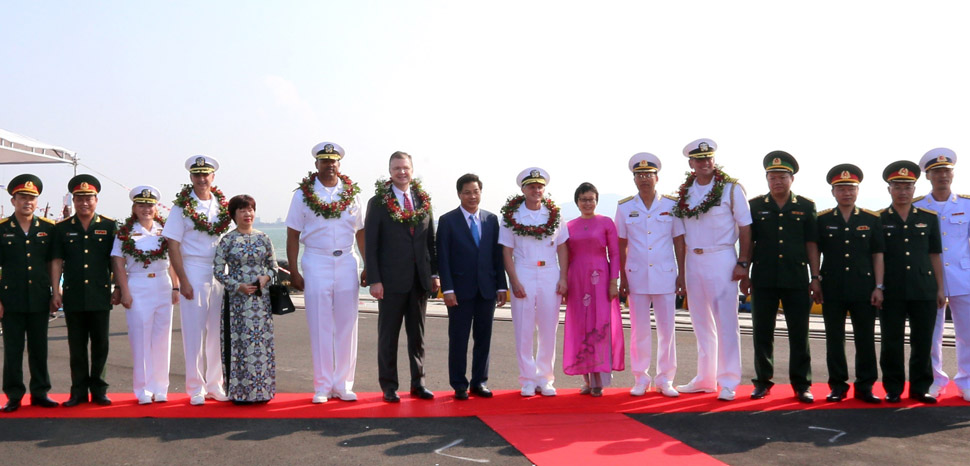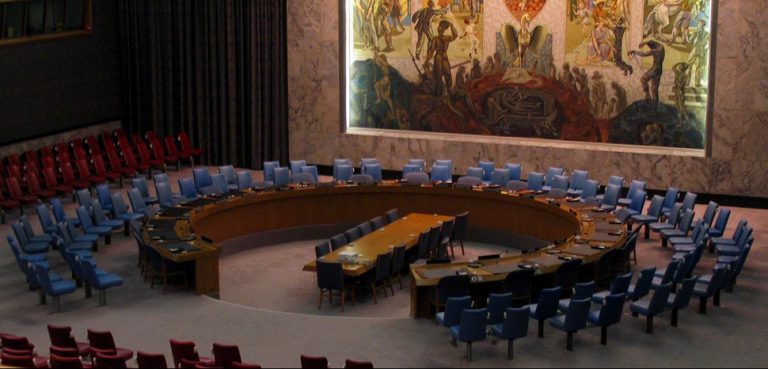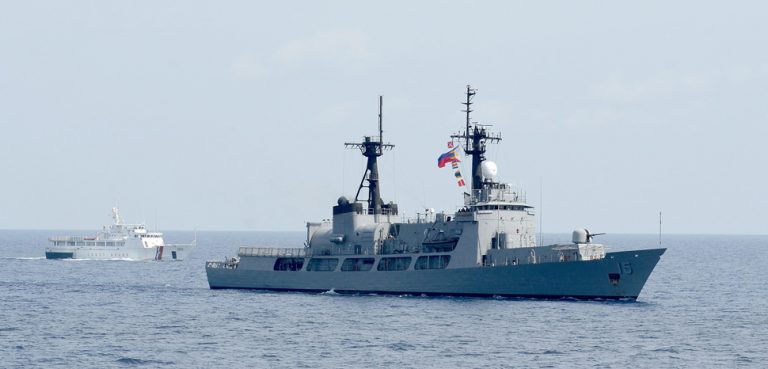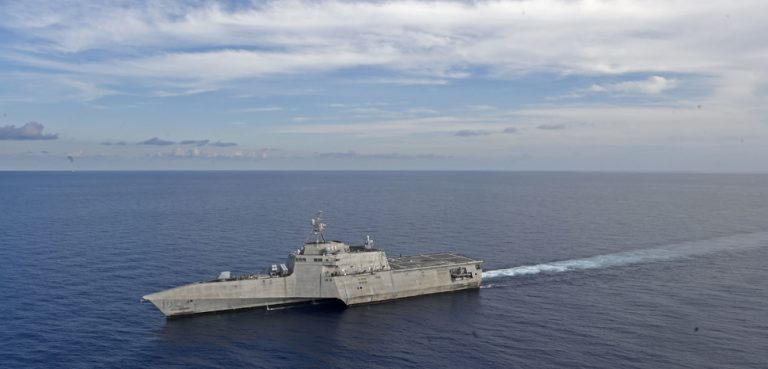Much has been written about US and Vietnam relations since the last helicopter lifted remaining American personnel from the rooftop of the US Saigon Embassy during the 1975 final evacuation, as the final curtain closed on the tragic Vietnam War. Once enemies, Washington and Hanoi are now deeply invested in friendship, mutual respect and peace, working to ensure stability and to uphold freedom of navigation and sustained commerce in the South China Sea.
Vietnam, along with other claimant nations, realize that they can no longer take on China’s advance alone. Beijing’s ambitious naval expansion, militarization of reclamations, and mega-trawler fishing operations challenge Hanoi and other regional nations in the South China Sea. Oil and gas resources, the depletion of species biodiversity, collapsing fish stocks, and overall security—all contribute to the growing importance of the SCS region.
Concerns over China’s intentions to control SCS shipping lanes, along with the creation of its military bases on seven remote Spratly Islands reefs (Cuarteron, Fiery Cross, Gaven, Hughes, Johnson, Mischief and Subi) are alarming both regional stakeholders and Washington. Overall, China’s land reclamation has roughly tripled the size of the entire group of natural islands. While other claimant nations have reclaimed land as well, the total by China over the past several years is equivalent to 17 times of what others have done in the past 40 years.
Vietnam knows all too well the conflicts associated with Chinese measures to occupy and claim disputed islands.
January 19 marks the 45th anniversary of China seizing and and annexing the Paracel Islands, called the Xisha Islands by Beijing and the Hoang Sa Islands by Hanoi. In 1974, as US troops withdrew from Vietnam, China sent troops to the remote islands and more than 70 Vietnamese soldiers died in the resulting invasion. The two countries remain locked in a diplomatic struggle over a panoply of international law and conventions in their respective sovereignty claims.
In Ly Son Island, scores of Vietnamese fishermen commemorate the deaths of those Vietnamese who bravely defended their archipelagos against the Chinese attack. Today, China, along with Taiwan and Vietnam, still legally claim the Paracels.
For now, Vietnam should welcome Washington and the Trump administration to expand the US freedom of navigation operational patrols in the South China Sea since they contribute to peace and security. The presence of US Navy warships streaming through one of the world’s critical merchant gateways bolsters confidence that the United States has not ceded the South China Sea to China.
Hanoi reveals a new geopolitical chart as they continue to navigate a closer and more comprehensive partnership with the United States. Their charm offensive was witnessed over the past several years with White House visits by Vietnam’s former President Truong Tan Sang, Prime Minister Nguyen Tan Dung, and Communist Party head Nguyen Phu Trong. Two years ago, the Vietnamese Prime Minister Nguyen Xuan Phuc was the first Southeast Asian head of state, and the third from Asia (after Japanese Minister Shinzo Abe and Chinese President Xi Jinping) to visit President Trump after he took office.
The cooperative ties between the U.S. and Vietnam date back to 1994, when President Clinton lifted the trade embargo against Vietnam and, soon after the normalization of diplomatic relations in 1995, the two governments signed the Bilateral Trade Agreement. This has since paved the commercial road for the steady and substantial growth of trade between the two economies, with an increasingly favorable balance of trade for Vietnam.
By 2006, the US Congress accorded Vietnam permanent normal trade relations status, which represented the completion of full normalization of economic ties and allowed Vietnam to join the World Trade Organization (WTO) in 2007 as its 150th member. While the Trump administration’s protectionist roadmap offers Hanoi some trade impediments, including the discriminatory anti-dumping treatment, policy experts remain bullish and optimistic about Vietnam’s progressive strides toward transforming into a market economy. Economists are quick to acknowledge that globalization has ushered in increased foreign investment in manufacturing plants like Nike in Vietnam, which employees over 400,000 young women.
The tide of foreign direct investment pouring into the country has yielded many dividends including a dramatic decline in Vietnam’s poverty, improved living standards and increased life expectancy. Hanoi’s cautious and sequential adoption of market institutions have yielded two decades of impressive economic performance. “Nike and Coca-Cola triumphed where American bombs failed. They made Vietnam capitalist,” claims Johan Norberg, a senior fellow at the Cato Institute in Washington.
It was encouraging news for Hanoi when last month the US Congress approved the Asia Reassurance Initiative Act (ARIA), which was signed into law by President Donald J. Trump on December 31. The Act affirms and advances the US National Security Strategy to “develop a long-term strategic vision and comprehensive, multifaceted and principled US policy for the Indo-Pacific region.” A few of the key articles that bolsters confidence in SCS claimant nations, especially Vietnam, are the following:
- Improves the defense capacity and resiliency of partner nations to resist coercion and deter and defend against security threats, including foreign military financing;
- Offers mechanism to conduct bilateral and multilateral engagements, particularly with the United States’ most highly capable allies and partners, to meet strategic challenges, including (destabilizing activities by China and North Korea’s nuclear and ballistic missile programs);
- Increases maritime domain awareness programs in South Asia and Southeast Asia;
- Encourages responsible natural resource management in partner countries, which is closely associated with economic growth;
Defense Cooperation Sends Message to China
Renewed Vietnam-US military cooperation is best symbolized by the nuclear-powered aircraft carrier USS Carl Vinson’s arrival in Da Nang last year, marking the first time such a ship has docked in the country since the Vietnam War. The Nimitz-class supercarrier with its 6,000 crew members, anchored off the coast of Da Nang and marked the largest US military presence in Vietnam since the war ended in 1975.
This display of military cooperation and reception was also highlighted in 2016, when former President Obama lifted a decades-old ban on the sale of military equipment to Vietnam.
The US-Vietnam defense relationship has included regular Naval Engagement Activities (NEA) over the past decade primarily to curb China’s assertiveness in the contested South China Sea.
Furthermore, in 2017, the U.S. also transferred the decommissioned Coast Guard cutter Morgenthau to Vietnam’s Coast Guard, and signed a three-year plan for defense cooperation. In addition, the US Pacific Partnership has made regular humanitarian relief exercises with its fast transport ships to the coastal city of Nha Trang to provide humanitarian and disaster relief. Vietnam’s leadership does believe that both a symbolic and cooperative defense relationship with the U.S. promotes regional and global peace and security.
Finally, the U.S. should consider the benefits associated with the US Congress ratification of U.N. Convention on the Law of the Sea (UNCLOS). It was adopted in 1982 and one hundred and sixty-two countries, including China and Russia, are signatories to the treaty that governs the world’s oceans. The U.S. has yet to adopt it.
While the US Navy’s Seventh Fleet continues to reinforce freedom in the South China Sea’s disputed waters, the treaty formally defines the limits of a country’s territorial sea, establishing clear rules for transit through “international straits,” and “exclusive economic zones (EEZs).” In short, it would allow the US military complete freedom of action.
With ratification, the United States would have legal standing to bring any complaints to an international dispute resolution body and thus avoid possible confrontation with Chinese naval forces and paramilitary fishing trawlers in the Spratly Islands.
Furthermore, the treaty allows for formal cooperation with other countries, because almost all of Washington’s allies, neighbors, and friends are party to the Convention. The geopolitical message is simple: America requires maximum freedom both for naval and commercial vessels to navigate and to operate off foreign coasts without interference. Vietnam and other South China Sea claimant nations urge the U.S. to abide by UNCLOS’s provisions and for the US Congress to ratify it.
At this moment, it’s possible that China is merely banking on the US government’s political impotence – now on display in the shutdown – to translate into its regional ambitions going unchallenged.
The opinions, beliefs, and viewpoints expressed by the authors are theirs alone and don’t reflect the official position of Geopoliticalmonitor.com or any other institution.




